Cockroaches
All About Cockroaches
There are over 3500 species of cockroaches in the world. Approximately 69 species are found in the U.S. and fortunately only a handful are considered to be pests. Their existence dates back 350 million years. Most of the structure infesting species originated in Africa or Asia.
Roaches have chewing mouthparts and most are omnivores (eat anything). When outdoors, roaches will commonly feed on leaf litter; indoors they feed on starches, sugars, and meats.
They have gradual metamorphosis, egg, nymph adult. Cockroach eggs are stored in a purse-shaped sac called an ootheca. This ootheca contains two rows of eggs. When a female roach is carrying an ootheca she is said to be ‘gravid’. The hatching of an ootheca is called eclosion.
Roaches are known to transmit diseases. Salmonella and other food poisonings are commonly attributed to roach infestations.
There is a distinct odor associated with roaches and this odor varies based on the species. Excrement, secretions from abdominal scent glands, pheromones and spittle regurgitates while feeding make up the majority of the odors.
In all cases of roach infestation there are nonchemical methods that will aid in controlling most roach infestations and invasions.
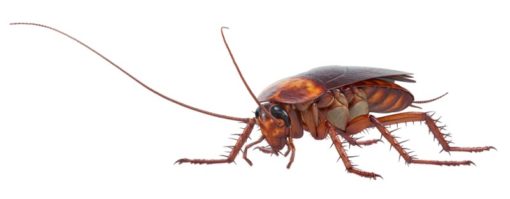
German Cockroach
The German roach is the most common roach worldwide. It’s nicknamed the Croton bug. The German cockroach is 5/8” long, brown and has two dark stripes on its pronotum. Nymphs also have the streaks that can be seen the entire length of their bodies. Males are more slender in appearance.
They have a higher reproductive rate than any of the other pest roaches, and in favorable conditions can grow from egg to adult in as little as 36 days. Female German roaches carry the ootheca until it’s ready to hatch (usually within 24 hours). There are usually 30-50 eggs per capsule but as many as 48 eggs have been recorded. A female that lives a normal life span (200 days) may produce 4-5 oothecae.
There are aggregation pheromones in the German roach’s fecal smears that attract other German roaches (especially nymphs). These areas of fecal smears are known as ‘fecal focal points’.
The German cannot fly and is rarely found outdoors in nature. It is transported to homes and other structures via packaged food, furniture and other items. Its home range is about 10 feet.
When in a structure, this critter is mostly found in cracks, crevices and void areas of kitchen and bathrooms. These areas should be treated with baits or residuals (they have an aversion to glucose).
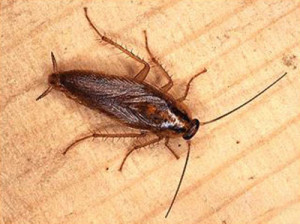
Brownbanded Cockroach
Family: Blatellidae – Supilla longipalpa
The Brownbanded cockroach is so named because of the two light brownish yellow stripes or bands on its wings. The males and females look very different from one another with the females being much broader and shorter than the males.
This roach species can be found in cupboards, pantries and other rooms of the house. It can be found in shelves of closets, behind picture frames and other high locations. This critter does not have the high moisture requirement that the German roach has so it may be found infesting offices and other dry areas.
The brownbanded female has a habit of hiding oothecae in furniture which probably has aided in their spread from Miami northward. She can become gravid without mating. The female carries the ootheca for 24-36 hours, then attaches it to an object. There are up to 18 eggs per capsule.
Brownbanded cockroaches will readily fly when disturbed.
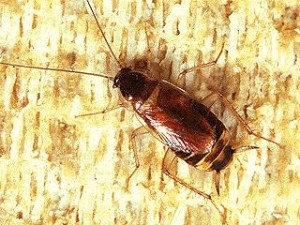
Asian Cockroach
Family: Blatellidae- Blatella Asahinai
The Asian roach is identical in appearance to the German roach. The only reliable method of differentiating the two species is by analyzing the waxy layer of the exoskeleton.
Although they may look alike, the behavior of the Asian and German roaches is very different. The Asian roach is a good flier and lives outdoors. It can be found in leaf litter and grassy areas.
Populations of Asian roaches peak during early spring and summer and become nuisance pests in homes. At dusk they will fly towards lights reflected off of light colored walls, windows and doors. Once inside a structure they will rest on lighted surfaces such as the TV screen, lamp shades and lighted walls.
Treatment should be directed outdoors at the source of the infestation. Baits scattered in the infested area have been successful in controlling Asian roach populations.

American Cockroach
Family: Blattidae- Periplaneta Americana
The American roach is the largest of the house infesting roaches. It is typically 1 ½” long but can get up to 2 1/8”. It is reddish-brown with light markings on the pronotum and has fully developed wings. The male has a pair of cerci and a pair of styli at the end of its abdomen and its wings extend beyond the abdomen. The female has only cerci and her wings extend to the end of her abdomen but not beyond. They are very capable fliers.
It is nicknamed the palmetto bug, water bug, and Bombay canary. It is one of the most common roaches on ships. It is commonly found in sewers and basements especially around pipes.
The American roach female carries the egg for a few hours up to 4 days before it is dropped into a crevice or glued to a surface. There are typically 16 eggs per capsule.
American roaches prefer fermented foods. They can easily be caught in a trap containing beer.
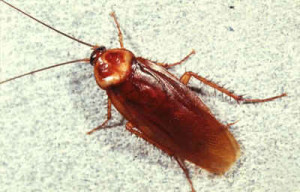
Smokybrown Cockroach
Family Blattidae – Perplaneta fuliginosa
The Smokybrown cockroach can be distinguished from the other peridomestic roaches by its uniform mahogany color. It is a little shorter than the American at 1 ¼”. The nymphs can be recognized by the white tips at the end of their antennae. It can be found in the North and North central parts of Florida.
The Smokybrown roach loses moisture through its cuticle more readily than other species and therefore require liquid every 2-3 days. They are found in sewers and loose mulch outdoors and block voids and attics indoors. They are commonly found around eaves and soffits that have moisture problems. Treatment of attics is critical for indoor population control. Both indoor and outdoor applications of insecticides are important in gaining long-term control.
The Smokybrown has well developed wings that extend beyond the end of the abdomen and they are very good fliers.

Australian Cockroach
Family: Blattidae – Periplaneta australasiae
The Australian roach is also peridomestic- living outside around homes. It can be distinguished from other large roaches by the yellow stripes on the front area of its wings. It also has a dark bat wind shape surrounded by yellow on its pronotum. The nymphs have yellow splotches on the margins of their abdomen. The adults get up to 1 ¼” long.
It is usually associated with plants and is commonly found in greenhouses. It feeds on dead and living plants and is found in and around homes that are heavily landscaped.
The ootheca will contain 24 eggs, 16 of which will hatch.
The Australian roach is a good flier.
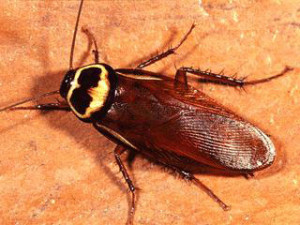
Oriental Cockroach
Family: Blatta orientalis
The oriental roach is rarely found in Florida since they prefer temperatures of 68 degrees F to 84 degrees F. It is nicknamed the black beetle because it is dark brown in color. It can get up to an inch in length.
The male oriental roaches have fully developed wings but they only cover 2/3 of their body. The females are shiny and have rudimentary wing pads but no wings. Neither can fly. The female is broader and drags her abdomen when walking. The male has a pair of styli between its cerci. It is also nicknamed the shad roach.
Outside the Oriental roach is found in sewers and trash containers. Inside it can be found in dark damp basements and has been known to climb water pipes and garbage chutes to upper floors.
Barrier treatments with microencapsulated products especially in June will help prevent entrance of the Oriental roach. This is a gregarious species living together in almost a colony like atmosphere.
The female carries the ootheca containing 16 eggs for thirty hours before depositing it.
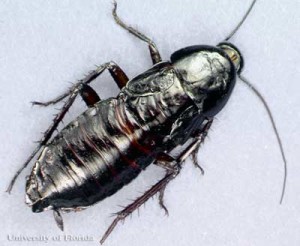
Florida Woods Cockroach
Family: Blattidae – Eurycotis floridana
The Florida woods roach is also known as just the ‘woods’ roach and also the stink bug. It is large, growing up to 1 ½” long and dark brown to almost black. Neither the male nor female have wings. They have rudimentary wing pads and are therefore incapable of flying. It is the only pest species that is native to Florida.
It infrequently gets into homes. Outdoors it can be found in lumber and firewood piles, leaf litter, under palmetto fronds, tree holes and in debris along buildings.
The nickname stink bug comes from its defense mechanism of spraying an oily smelly secretion from a gland on the underside of its abdomen.

Surinam Cockroach
Family: Blaberidae- Pyncnoscelus surinamensis
The Surinam is a medium sized roach at ¾ to 1 inch. The pronotum is uniformly dark and its wings are a dark olive-green.
It is a burrowing species and is often brought into homes in potted plants. It is found in the south and in greenhouses in the northern states. It is not cold tolerant.
Outside in the south it is found in the soil at the base of trees and shrubs and under turf grass thatch during the day. It will emerge at night and flies towards lighted areas. They feed on live plants.
This roach has no males. The female can reproduce parthenogenetically (without males).
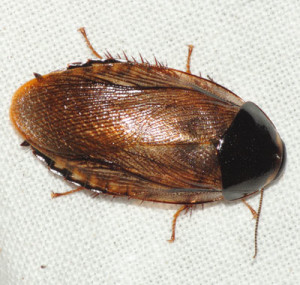
Cuban Cockroach
Family: Blaberidae – Panchlora nivea
This roach is pale green in color and is brought into this country in bananas.
They are fast and fly extremely well. When they are placed in alcohol they lose their pale green color.
It is attracted to lighted doors and windows. Outside it is found in firewood piles, lawns and wooded areas that are moist, shaded and have lots of leaf litter.
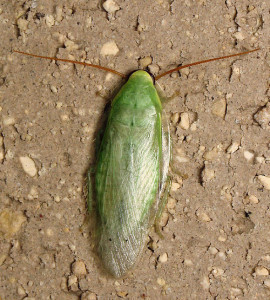
Control Strategies
In all cases of roach infestation there are nonchemical methods that will aid in controlling roach infestations and invasions.
- Sanitation- remove food and water
- Removing harborage sites- throw out (recycle) cardboard boxes
- Denying access to harborages- caulking and sealing*
- Trapping- glueboards
- Physical removal- vacuuming
* Sealing cracks and holes on the outside of buildings is one of the most important steps in preventing peridomestic roaches from entering a structure.
Residual insecticides should be used to treat directly in the harborage areas of as a perimeter barrier treatment to prevent entrance.
- German roaches became resistant to Chlordane and there are strains that are resistant to Organophosphates and Carbamates IGRs are substances that act like growth hormones in the roach’s body. They prevent normal growth of the critter. The currently available products are juvenile hormone analogs. Hydroprene (Gentrol) and Pyriproxyfen (Nylar and Archer) are JHA’s that sterilize roaches. Baits have improved over the years are now are a major component in roach control
- Abamectin kills pests by blocking electrical activity in nerves and muscles
- Sulfuramid and Hydramethylnon are metabolic toxins that block and disrupt energy pathways
- German roaches have developed an aversion to glucose (a form of sugar) so fructose is now used
- Moist baits are more readily accepted than dry baits especially with German roaches
Proudly Serving
Sun City Center, Ruskin, Palmetto, Parrish, Ellenton, Bradenton, Anna Maria, Holmes Beach, Bradenton Beach, Longboat Key, Lakewood Ranch, University Park, Myakka City, Sarasota, Siesta Key, Osprey, Nokomis, Casey Key, Venice, Englewood, North Port, Port Charlotte, Punta Gorda, Arcadia
Things You Can Do
Pay Your Bill Online
Leave Us a Review
Request a Free* Termite Inspection
Stop Mosquito Bites
Get Rid of Rodents
Get a Termite Damage Warranty
Get Pest Control for Your Attic
Get Pest Control for Your Business Request Prayer
Corporate Address
1080 Enterprise Court, Ste A
North Venice, FL 34275
Call Now: (941) 412-9610
Text: (941) 412-9610
Fax: (941) 412-0080
